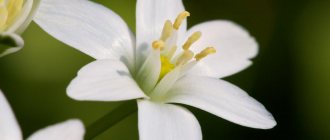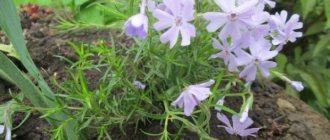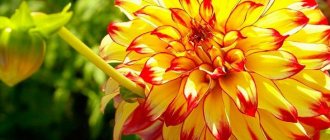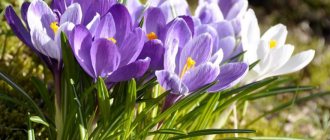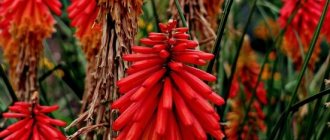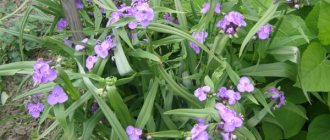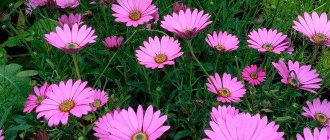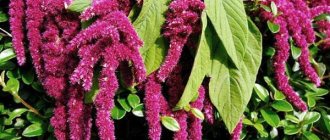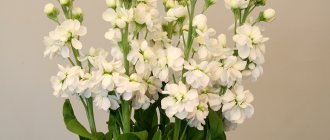Author: Elena N. https://floristics.info/ru/index.php?option=com_contact&view=contact&id=19 Category: Houseplants Published: October 26, 2011Republished: February 25, 2019Last edits: March 11, 2021
- Jasmine beesianum / Jasminum beesianum
Description
It is a climbing or erect, evergreen shrub of the olive family. The leaves are uniformly green in color, trifoliate or odd-pinnate in shape.
Flowers with a large corolla of regular outline, white, pale yellow or pink, with a pronounced sweet aroma. Flowering ends with the formation of an inedible berry.
The habitat today is represented by almost all the warm edges of the planet - from Africa and Australia to central America and southern Europe.
Some types of jasmine also grow in Russia, the northern Caucasus, Crimea, Kuban, Altai, and Southern Urals. Artificial cultivation is widely practiced in China.
Varieties
More than 250 varieties of this plant are known, which appeared through natural processes or created by breeders. The most famous and widespread.
Turned away. It is distinguished by bright yellow inflorescences and a strong aroma throughout the entire flowering period. Honey plant actively attracts bees and other insects. The leaves are paired, bright green.
Sambac. A liana-like variety that can grow up to 6-8 meters in length. Large leaves, and neat white inflorescences are collected in fragrant bouquets. The woody stems give a special aesthetics; landscape designers and those who like to decorate their garden plot with hedges liked all this.
Flattened. A shrub that, if properly pruned, pleases with a large number of flowers in soft pink shades and an equally refined scent that exudes all summer.
Bisa. One of the most popular decorative varieties. The vines reach a length of 2-3 meters and are strewn with umbrellas of large bright pink inflorescences with a bluish tint. If desired, you can also give it a bushy form. Combined with large, dark green leaves to create a wonderful tool for forming a living wall.
Drug. The most popular among window sill pharmacy lovers. Despite its main purpose, it has good decorative qualities. Smooth branches covered with oblong leaves and white racemose inflorescences look quite nice, and they will delight you with flowering for a long time - from April to autumn.
The thinnest. It is distinguished by “falling” shoots and large white inflorescences. The aroma, although not as pronounced as that of the above-described species, has pleasant specific notes. The leaves are dirty green, slightly pubescent at the base.
Multi-flowered. A very large, lush shrub up to two meters high, during the flowering period it is covered with an abundant “carpet” of pink and white flowers. It has the most powerful aroma of all known varieties. In addition, it is easy to recognize by its unusually shaped leaves, reminiscent of a wavy dagger.
Large-flowered. As can be understood from the name, it is distinguished by large white flowers, collected in umbrellas of 7-10 pieces. The shoots themselves can be up to ten meters long, which provides wide decorative possibilities, but imposes some pruning responsibilities.
Reproduction
The plant propagates vegetatively - by dividing the root system and semi-lignified apical cuttings, which have 3 internodes (2-3 pairs of leaves). In summer, cuttings of green shoots can be taken to propagate jasmine. Cut just below the leaf node.
- The lowest pair of leaves is removed, the remaining ones are cut in half.
- A cut of the cutting is dipped into powder - a stimulator of root formation, and then buried 2 cm in a moist mixture prepared from equal parts of universal soil and sand (vermiculite).
- After which the cuttings are covered with a transparent bag or plastic bottle to create greenhouse conditions.
- During rooting, the soil should be moist all the time, but not wet.
When signs of new growth appear, the seedlings can be transplanted into pots of fertile soil, several per pot, to produce a strong, bushy plant.
Growing
When planting jasmine in our difficult latitudes, you need to take into account the following nuances:
- the plant is not particularly demanding on the mineral composition of the soil, but if you need an intoxicating aroma and abundant flowering, it must be fertile;
- plant either in early spring or late autumn - this is the best time for rooting;
- You should pay close attention to the behavior of groundwater and water circulation in the area as a whole, and plant only in places that are not subject to stagnant water, or neutralize them using crushed stone cushions.
The hole for planting jasmine should be about half a meter deep, and you need to add a little nitrogen-phosphorus fertilizer to it. After planting and compacting, it is necessary to water abundantly.
Care
Caring for polyanthus jasmine at home has some special requirements, without which the plant will not be able to please with active development and lush flowering. Among them it is worth noting:
- love of light;
- humidity and temperature requirements;
- nuances of care during a pronounced period of rest.
Where to put
In order for the plant to develop well and bloom profusely, you need to choose the brightest place in the room for it, but it is worth considering that direct rays should not fall on the flower. The best option is a western or eastern window sill.
Windows facing south can be considered as a potential place for installing a pot only if they are equipped with modern blinds or another shading system that, on the one hand, will not block the light from the flower, and on the other hand, will make the lighting diffuse.
Humidity and temperature
Dry air in the house is the main enemy of polyanthus; it causes the bush to hurt and stop blooming. It is important to spray the plant regularly, including during flowering, covering the flowers. In addition, place a tray of water nearby and add pebbles.
In terms of air temperature (regarding the growing season), jasmine is undemanding and will tolerate even 25 degrees of heat, provided there is abundant and frequent watering and spraying. The exception is the rest period.
Rest period
Unlike jasmine sambac, multifloral jasmine needs a period of rest. As winter approaches, the bush even begins to lose its foliage, and then the pot must be taken out into a cool room with a temperature of no more than 12 degrees Celsius, otherwise the next flowering can take a long time, and if it does bloom, there will be few buds.
Watering before the bush “rest” begins to be gradually reduced, and in winter the soil is moistened infrequently. Plants overwintering in a cool room are not sprayed.
Trimming
Polyanthus responds well to haircuts. This way you can “kill two birds with one stone”:
- restrain its too active growth;
- stimulate the formation of young side shoots, on which flower buds subsequently form.
Also, during the spring-summer period, the tops of the branches are pinched.
Transfer
Spring is the right time to replant your jasmine. The plant is just finishing its flowering. When transplanting, you can prune. Transplantation is done if the plant becomes cramped in a pot or flowerpot. We select a larger pot.
In the summer, a pot of polyanthus jasmine can be taken out to the balcony or even taken to the country:
Preparing for winter
The wintering period involves a decrease in temperature to +10...+12°C, so if you have a closed balcony, it can be used to transfer a flower there. At the same time, watering is reduced to a minimum, fertilizing is stopped completely, and a place is chosen that is as shaded as possible.
Features at home
If you plan to use jasmine as an indoor flower, then it should be placed in spacious rooms. A powerful aroma is wonderful in an open garden, but in a confined space its abundance can have a detrimental effect on well-being.
The plant itself can suffer from the wrong location and tap water. Sun rays refracted through double-glazed windows can burn delicate foliage, causing it to yellow and die.
- Butterflies: beautiful creatures from the world of insects
How to grow excellent petunia seedlings
- How to properly water an orchid in a pot: the benefits of automatic watering for the plant
The same goes for hard tap water. To avoid these troubles, you need to use a softening filter and choose a place without excessive sunlight.
If these conditions are met, but your bush still does not want to bloom, most likely there were errors during planting in the form of too deep grounding. The solution is to replant so that the rhizome sticks out of the ground a little. The cause may also be insufficient soil acidity, which can be solved with appropriate fertilizers.
Preparing for winter
In order for jasmine to successfully overwinter in the garden, it needs to be prepared:
- In the fall, the soil around the bush is dug up - not too deep, so as not to damage the roots.
- Compost mulch is added to the tree trunk circle. This measure will keep the roots from freezing.
- The jasmine bush itself needs to be covered with non-woven material, forming something like a tent.
Adult plants do not need as much care as young ones. They have sufficient frost resistance; It will be quite enough to mulch the tree trunk circle with high quality.
Application
Who hasn’t drunk green tea with jasmine flowers, the properties of which give the drink a unique range of smells? This combination is so loved by consumers that today it can be found in any store. It is also used as a flavoring agent for confectionery products, alcoholic beverages and other food products.
It is curious that photos of jasmine flowers on tea boxes are sometimes images of mock orange. These plants are often confused due to their similar aroma and appearance.
In addition to its decorative and gastronomic value, some of the properties of this universal plant have found application in folk medicine and medical cosmetology.
Diseases and pests
If Jasmine is cultivated as a houseplant and kept in a warm place with poor ventilation, especially in winter, it may become infested with aphids or mealybugs. They should simply be removed by hand or washed off. If that doesn't work, the best way to control these pests is to use insecticides. Garden Jasmine has problems related to location and care errors. The biggest problem here is often soil that is too wet, which causes the roots to rot quickly or over time.
Healing properties
The benefits of jasmine flowers are due to the high content of many essential acids and essential oils. Leaves and flowers, due to the presence of salicyl-containing elements in them, have mild antiseptic properties sufficient to disinfect cuts.
Essential oils and flower decoctions are widely used as a tonic that has a beneficial effect on all organ systems, especially the nervous one.
There is also a positive effect on the female body during lactation and menstruation. Medicines for insomnia and migraines are prepared from the roots.
People with hypertension and stomach ulcers, as well as allergy sufferers, should be careful when using jasmine.
Jasmine price
to buy jasmine flowers for 500-700 rubles. This is what they ask for for 0.5 kilograms of dried buds. Their purchase makes it possible to create tea compositions yourself and enrich ready-made mixtures from stores.
Essential oil of jasmine flowers does not cost less than 100 rubles per 10 milliliters. Standard price is 150-250 rubles. As for potted plants, you will have to fork out about 700-800 rubles. This is the cost of bushes 20-30 centimeters high, in plastic pots with a diameter of 12-15 centimeters. If the jasmine is in bloom at the time of sale, they usually ask for 900 rubles.
